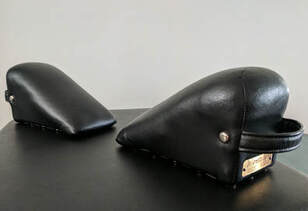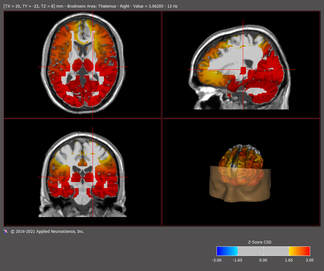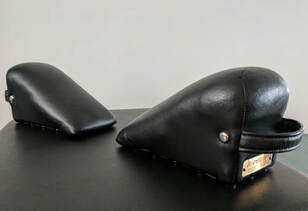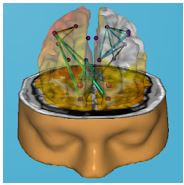 I recently had the pleasure of taking a course intitled Synaptogenesis and Cognitive Decline, which was taught by two AK docs: Dr. Chris Astill-Smith, DO, ND, DIBAK and Dr. Joe Schafer, DC, DIBAK. This course focused on things that affected cognition including diseases such as dementia, Alzheimer's, Parkinson's, stroke, cognitive changes from COVID, and traumatic brain injury. I have been using this knowledge, especially the work of Joe Schafer, in my practice. One of the methods utilizes specific muscle testing and magnets placed on the head to identify key areas of the brain that are negatively affecting a person. One can then contact different points on the body that correspond acupuncture meridians. Keep in mind these are points I contact with my hand, not with needles! I have seen some pretty rapid and impressive changes in people by doing this. These good outcomes include people with traumatic brain injury and stroke, as well as some of my neurofeedback patients to add an extra boost to therapy. I also flew to North Carolina to have this done on me by one of my AK mentors as there is nobody in the area who does this kind of work. I found it to be both intriguing and helpful! Please contact the office if you would like to try this therapy or if you already have an appointment let me know and we can see if it would be the right therapy for you! 727-509-3760.
1 Comment
 Using Sacro Occipital Technique, wedge-shaped blocks are placed under the pelvis to correct imbalances in the sacroiliac joint and lumbar spine. This gentle low force technique can have far reaching effects and has been shown to change brainwave patterns. Using Sacro Occipital Technique, wedge-shaped blocks are placed under the pelvis to correct imbalances in the sacroiliac joint and lumbar spine. This gentle low force technique can have far reaching effects and has been shown to change brainwave patterns. For better or worse, going to a chiropractor is synonymous with a "cracking" or "popping" noise. As a chiropractor, when I meet people, they often ask "hey doc, can you crack my back?" On the other hand, a large number of patients contact me because they don't want someone to crack their back. The good news for those who don't want their back cracked is that it never has to happen at my office if the patient doesn't want it. But since this is the topic of this blog post, here is just a little more info on what is really going on. Simply put, the cracking noise associated with chiropractic adjustments is a gas exchange in the joints of the body. Cracking your knuckles is a gas exchange in a joint. It is no different in your spine. When a joint is extended beyond its end range of motion, or paraphysiological space, there is often a noise. The cracking comes from a type of adjustment called high velocity low amplitude (HVLA). Traditional chiropractic adjustments often elicit this noise because they bring joints into the paraphysiological space, and a gas exchange occurs. But does that noise mean you have fixed anything? The answer is...sometimes. Having been involved in numerous research studies, I attend research conferences, where I have learned from the more recent research that the noise really has very little to do with the neurology of what a chiropractor is trying to do. For me, chiropractic isn't about making noise, it's about changing neurology. Often, the chiropractic adjustment affecting neurology will make that noise. People begin to associate the crack with feeling better. That is called paired learning, and both patients and chiropractors themselves think that noise MUST occur for the adjustment to be a success. I find that simply isn't true, and more recent research is confirming my findings. I am trained in a variety of techniques that don't involve popping and cracking, including Sacro Occipital Technique (SOT), Activator, Thompson, Dynamic Spinal Analysis, Advanced Chiropractic Techniques and Cox flexion distraction. A certain segment of my patient population seeks me out because they don't like the noise produced by traditional methods of chiropractic. Some patients have joint hypermobility - the joints move too much. For those patients, popping and cracking the joint will make it more hypermobile. There may be temporary relief, but the problem isn't being solved, and it could be making them worse. This is especially true of the sacroiliac joint when there is hypermobility in that joint. I find that a lot in my practice. Also there are disorders like Ehlers-Danlos Syndrome (EDS), Marfan syndrome and other conditions where people have weak ligaments which shouldn't be stretched further. With all that being said, in my office corrections are made based on neurological indicators based on analysis. Adjustments can be with or without the noise. A lot of the time I find the noise is unnecessary. So, if you don't like the crack, no problem! Call my office in Palm Harbor, FL to schedule an appointment.  The maxlla is pictured here in red. It is a very important bone for the function of the body, and this includes TMJ/TMD problems. The maxlla is pictured here in red. It is a very important bone for the function of the body, and this includes TMJ/TMD problems. When people talk about Tempromandibular Joint (TMJ) problems or tempromandibular dysfunction (TMD), they are thinking of the actual joint. Indeed, the TMJ is a very important and complicated joint. People will feel pain in that area or hear popping or clicking. But the function of the joint is so dependent on other areas of the body! One such area is the maxilla. It's a bone in your head that you most likely haven't heard of, but it's the one your top teeth come from. It is what your jaw makes contact with every time you eat, drink, or swallow. The maxilla makes up the base of the anterior 2/3rds of the skull. If the relationship between the jaw and the maxilla is balanced, then they work together to help reinforce a properly functioning cranium and temporomandibular joint. However, if the position of the maxilla shifts, then you have the jaw (mandible) making contact with an unbalanced surface. I routinely check and correct issues with the maxilla in my office since it is important to everyone's general health. In TMJ, it becomes an especially important bone to give attention to because of its relationship to the jaw and its connection with other cranial bones in the body. These include the zygoma, frontal, nasal, palatine, lacrimal, ethmoid, nasal concha, and volmer. The position of the maxilla can affect the position of these other bones, which in turn connect to other parts of the body in a chain. A properly positioned maxilla can help keep a healthy body, but a distorted maxilla can cause all sorts of problems. For example, there is an intricate relationship between the position of the maxilla and the position of the C1 vertebra, or atlas vertebra. It is impossible to fully balance a C1 vertebra without balancing a maxilla. Another issue with the maxilla is a narrow palate. There is an association with a narrow palate and airway compromise, snoring, sleep apnea, and forward head posture. In infants, palate issues can relate to sucking and nursing issues. Chiropractic craniopathy can be quite effective in dealing with palate issues, especially in children as the palate develops. Sometimes the maxilla requires dental intervention to help support the cranial corrections being made at my office. A simple adjustment to the occulsion (the way teeth touch) by a dentist can stabilize the maxilla. The ALF (Advanced Lightwire Functional) is a thin wire that can be placed behind the teeth to help support cranial corrections through the maxilla. This needs to be done by a dentist with advanced training in ALF and lots of experience using it. Expansion of the maxilla will occur with an ALF, but unlike other "palate expanders", special care is given to make sure the expansion will reinforce stability in the cranium. My advanced training in chiropractic craniopathy gives me the skill to assess the maxilla and its relationship with other parts of the body. If you have a "TMJ" problem or TMD, I can evaluate the function of your maxilla and see if it is contributing to your problem. Please contact my office in Palm Harbor Florida to schedule and appointment.  Obsessive Compulsive Disorder (OCD) is comprised of two parts: obsessions and compulsions. Obsessions are thoughts and compulsions are behaviors. OCD is classified as an anxiety disorder because it is generally driven by anxiety. Obsessions are unwanted, intrusive thoughts that cause a person distress. Compulsions are behaviors in which a person engages to reduce the anxiety caused by the obsessions. Common compulsions that the general public is familiar with include when people will engage in checking behaviors and cleaning behaviors. The variations of presentation of OCD are quite extensive and not the focus of this blog entry. But whatever the presentation, OCD can be a debilitating condition. Some of the more effective treatments for OCD historically has been exposure therapy and cognitive behavioral therapy. Medications, especially selective serotonin reuptake inhibitors and tricyclic antidepressants, are generally most effective for OCD. But medication is not able to help all cases. Additionally, medications can have unwanted side effects. Some people refuse to engage on exposure therapy because it is by definition unpleasant.  Brain image of a patient with OCD who has elevated activity in various locations in the brain related to OCD symptoms. Brain image of a patient with OCD who has elevated activity in various locations in the brain related to OCD symptoms. Neurofeedback offers another treatment for OCD which can be very effective in treating all components of OCD including anxiety, obsessions and compulsions. In my office, a brain map (also known as qEEG analysis) is conducted to identify areas of the brain that have been found in research to relate to OCD. Areas of the brain frequently found dysregulated include the cingulate gyrus, anterior cingulate gyrus and orbitofrontal cortex (Brodmann area 11). Other regions can be involved including other parts of the frontal cortex, insula and the amygdala, which drives anxiety. I almost always find excessive theta wave activity in the anterior cingulate in patients with OCD. After identifying which specific areas of the brain are dysregulated, Neurofeedback can be done to retrain these areas of the brain linked to OCD symptoms. Patients then report improvement in OCD symptoms. I do additional testing such as the Yale-Brown Obsessive Compulsive Scale (Y-BOCS) to get baseline measures of function and then track improvement. When Y-BOCS scores are normalized, treatment stops. I then track patients over a period of 6 weeks to see if scores remain normalized. In all the cases of OCD I have treated, the improvements made are permanent and no other therapy is needed. Some research has been done on OCD and Neurofeedback. Articles are listed below. If you or someone you know suffers from OCD, help is out there. Please contact my office in Palm Harbor, Florida and schedule an appointment.
 SOT® uses wedge-shaped blocks placed under the pelvis to gently yet effectively bring the body, especially the sacroiliac joint, back into balance. SOT® uses wedge-shaped blocks placed under the pelvis to gently yet effectively bring the body, especially the sacroiliac joint, back into balance. In October of 2021, I received my Advanced Proficiency level of certification in Sacro Occipital Technique (also spelled Sacro Occipital Technic ® or SOT®). I already had a general certification in SOT®. This advanced certification documents a level of mastery in specific advanced parts of SOT®, including Chiropractic Manipulative Reflex Technique (CMRT) and chiropractic craniopathy. CMRT deals with the function of the organs in the body. It includes visceral manipulation to treat dysfunction in the organs that are contributing to people's problems. Conditions I frequently treat with CMRT are respiratory problems (including viral illnesses), allergies, gallbladder issues, stomach and digestive problems, adrenal dysfunction, liver issues, kidney issues, constipation, diarrhea, heartburn, gastroesophageal reflux disease (GERD), menstrual problems, menopause symptoms, and prostate issues. There are so many issues that can be helped with chiropractic craniopathy, since 80% of your nervous system is in your brain. Some of the more frequent ones I help in my office are headaches, traumatic brain injury, temporomandibular dysfunction (TMD; including dysfunction of the temporomandibular joint [TMJ]), trigeminal neuralgia, learning disabilities, tooth pain, dizziness, and vertigo. Babies' heads are often traumatized by the birth process, leading to problems like plagiocephaly, difficulty nursing or latching, and ear infections which can all be helped by chiropractic craniopathy. Chiropractic adjustments that do not hold can indicate an unresolved cranial bone issue. Since the brain controls the rest of your body, I've had cranial adjustments help things like neck pain, low back pain, sciatica, lymph drainage, and even ankle problems (really!). I am the only chiropractor in Pinellas County Florida with Advanced Proficiency SOT® level certification. Interested in knowing if SOT® can help you? Please contact my office to schedule an appointment.  NeuroNavigator swLORETA analysis shows dysregulation in the amygdala and other areas of the brain of this anxious patient treated at my office. NeuroNavigator swLORETA analysis shows dysregulation in the amygdala and other areas of the brain of this anxious patient treated at my office. Some anxiety is a normal part of life. But when anxiety levels increase to a point that it interferes with someone's health and happiness, help is out there. One of the therapies I used for anxiety is Neurofeedback. The first step is to utilize quantitative electroencephalography (qEEG) and do a brain map to identify the parts of the brain that are not functioning efficiently. Neurofeedback can then be used to retrain those dysregulated areas of the brain. When this is done, symptoms go away. In my office, patients report these changes to be permanent and I some of them years after treatment as they may choose to also pursue chiropractic care with me or may have been an existing chiropractic patient before Neurofeedback. More recent research has shown that there is an anxiety network in the brain. Different areas of the brain can be involved. These include the amygdala, the insula, the middle frontal gyrus and superior parietal lobule. For conditions like OCD, the anterior cingulate, cingulate, and orbitofrontal gyrus should be considered. PTSD includes other regions. There are other areas that may be involved, depending on patient symptoms. Do you or someone you know have anxiety? They may have dysregulation in these areas of the brain. The good news is there is treatment for this including Neurofeedback. I also do traditional psychotherapy and EMDR in my office, which may be more appropriate, especially if the anxiety does not have a brain basis. This is all part of the comprehensive analysis and diagnosis done at Tuttle Health, LLC in Palm Harbor, Florida.  swLORETA map of a patient with an Anxiety Disorder and ADHD showing excessive alpha activity in the thalamus and other areas of the brain related to presenting symptoms. swLORETA map of a patient with an Anxiety Disorder and ADHD showing excessive alpha activity in the thalamus and other areas of the brain related to presenting symptoms. Neurofeedback works on the brain. Through pioneering research I developed, I have been able to show that the technique of chiropractic I use, Sacro Occipital Technique, also affects brain function. Many "brain problems" that result in conditions like ADHD, ADD, PTSD, OCD, Traumatic Brain Injury, insomnia, depression and anxiety can be viewed as a brain being "stuck" in a physiological pattern that needs to be disrupted to change. Adding chiropractic to a Neurofeedback program, adds another way to disrupt old patterns and introduce new ones. For much of its history, Neurofeedback used one or two electrodes placed on the head. I have successfully treated many patients with this form of Neurofeedback. However, not all patients are the same. Sometimes Neurofeedback with one or two electrodes isn't what the patient needs to reach their treatment goals. For this reason, I have invested in additional technologies and forms of Neurofeedback. These include:
 Research I conducted showed that SOT® blocks placed under the pelvis resulted in changes in brain activity suggesting enhancement of neuroplasticity. Research I conducted showed that SOT® blocks placed under the pelvis resulted in changes in brain activity suggesting enhancement of neuroplasticity.
You have a choice as to who provides you therapy. With this variety tools in my toolbox, I can create an individualized treatment plan to help you reach your treatment goals as quickly and effectively as possible.  swLORETA image showing elevated alpha activity in the thalamus and cerebellum as well as other locations. swLORETA image showing elevated alpha activity in the thalamus and cerebellum as well as other locations. One of the new technologies I have for Neurofeedback is something called swLORETA z-score Neurofeedback. It is part of a program I used called Neuroguide. Traditional neurofeedback uses one or two electrodes on the head to increase or decrease a particular frequency or frequencies. swLORETA z-score Neurofeedback uses 19 electrodes on the head to train the brain in 3 dimensions. It divides the brain into over 12,000 voxels or pieces and calculates the brain activity at those locations. I then compare that data to a normative database to determine what areas of the brain are different from the average human. If those areas of the brain are different, and they relate to the symptoms a person is having, then we can re-train those areas of the brain. For the first time, swLORETA allows deeper structures in the brain like the cerebellum to be viewed using qEEG technology. The cerebellum is very important in balance and coordination disorders, conditions like Parkinson's and is also now even being found to be involved in things like attention. swLORETA stands for standardized weighted low resolution electromagnetic tomography analysis. Advantages to swLORETA Neurofeedback is that it is more specific than traditional neurofeedback. Because it is more specific, it is being reported to work faster than other forms of traditional Neurofeedback and may succeed where other forms of Neurofeedback have reached a plateau in progress. Neurofeedback can be used to treat anxiety, depression, PTSD, OCD, ADHD, Autism, insomnia, traumatic brain injury, and is being investigated for use in cognitive problems associated with COVID-19. You can be assured you are getting the latest and greatest in technology when choosing Neurofeedback at Tuttle Health, LLC. Call today to schedule an appointment. 727-509-3760.  Neurolink Q links patient's symptoms to locations in the brain. Neurolink Q links patient's symptoms to locations in the brain. Are you wondering what part of your brain might be involved in the problem you are having? Yeah, there's an app for that! There is a new app out called Neurolink Q. It allows a person to enter into it whatever symptoms they might be having and see what parts of the brain may be involved in generating their symptoms. For example if a person has anxiety, it will show what parts of the brain may be involved in generating anxiety. I use it in conjunction with a program called Neuroguide to do Neurofeedback with patients. I use Neuroguide in conjunction with a program called swLORETA which allows me to train the brain in three dimensions.  swLORETA technology shows elevated electrical brain activity in an anxious traumatic brain injury patient, show here with the yellow and red colors. swLORETA technology shows elevated electrical brain activity in an anxious traumatic brain injury patient, show here with the yellow and red colors. Neurolink Q can be used with the doctor and patient to see what parts of the brain may be involved and then see how the patient's symptoms are changing over time. The questions assess things like anxiety, depression, post traumatic stress disorder (PTSD), obsessive compulsive disorder (OCD), chronic pain, insomnia, attention deficit hyperactivity disorder (ADHD), early dementia, Parkinson's disease, alexithymia, autism, cognitive issues related to the coronavirus and various issues related to traumatic brain injury or concussion. If you enter this information, Neurolink Q does not send your information anywhere so you do not need to be concerned about privacy. If you WANT to send it to me, we can arrange for that but it takes additional steps. You can download the app here: http://anineurolink.com/mobile/APPgallery.htm Call 727-509-3760 to schedule an appointment. I am proud to announce that I am now a diplomate in QEEG (quantitative electroencephalography) as determined by the International QEEG Certification Board. QEEG is the mathematical analysis of brainwave activity and the skill and technology behind Neurofeedback. This is an advanced level certification currently only held by 126 other people in the world. This demonstrates a level of mastery that is not typically seen in most people providing Neurofeedback.
I already had the experience using qEEG technology having practiced and studied under great mentors in the field recording and processing thousands of EEGs and then conducting Neurofeedback with those patients. However, I saw the opportunity to refine and advance my skills even further and I chose to get this advanced certification. While over 100,000 studies have evaluated the use of qEEG, there is very little standardization as to how proficient a person is in using the technology, especially when used in a clinical setting (i.e., working with patients). One of the biggest advancements this certification gives is the ability to screen and read EEGs like a medical doctor does which is different than how they are read for Neurofeedback. This allows me to screen EEGs more effectively for red flags that would require a referral to a neurologist. It also brought me up-to-date on latest advancements in the field and ways of treating patients using Neurofeedback. Neurofeedback can be used to train a variety of brain-based conditions such as anxiety, depression, Post Traumatic Stress Disorder (PTSD), Attention Deficit Disorder (ADD), Attention Deficit Hyperactivity Disorder (ADHD), Traumatic Brain Injury (TBI), Obsessive Compulsive Disorder (OCD), insomnia, chronic pain, migraines and autism. In collaboration with neurologists, it can also be used treat epilepsy. Call my office at 727-509-3760 to learn more and schedule an appointment. |
AuthorI'm a Chiropractic Physician, Psychotherapist and researcher. I'm interested in helping people live their lives to their full potential. That could be simply without pain. Or it could be without more complicated physical or mental health problems. Or it could be getting help in making changes in their life so that they can achieve their dreams. Archives
June 2023
Categories |
 RSS Feed
RSS Feed